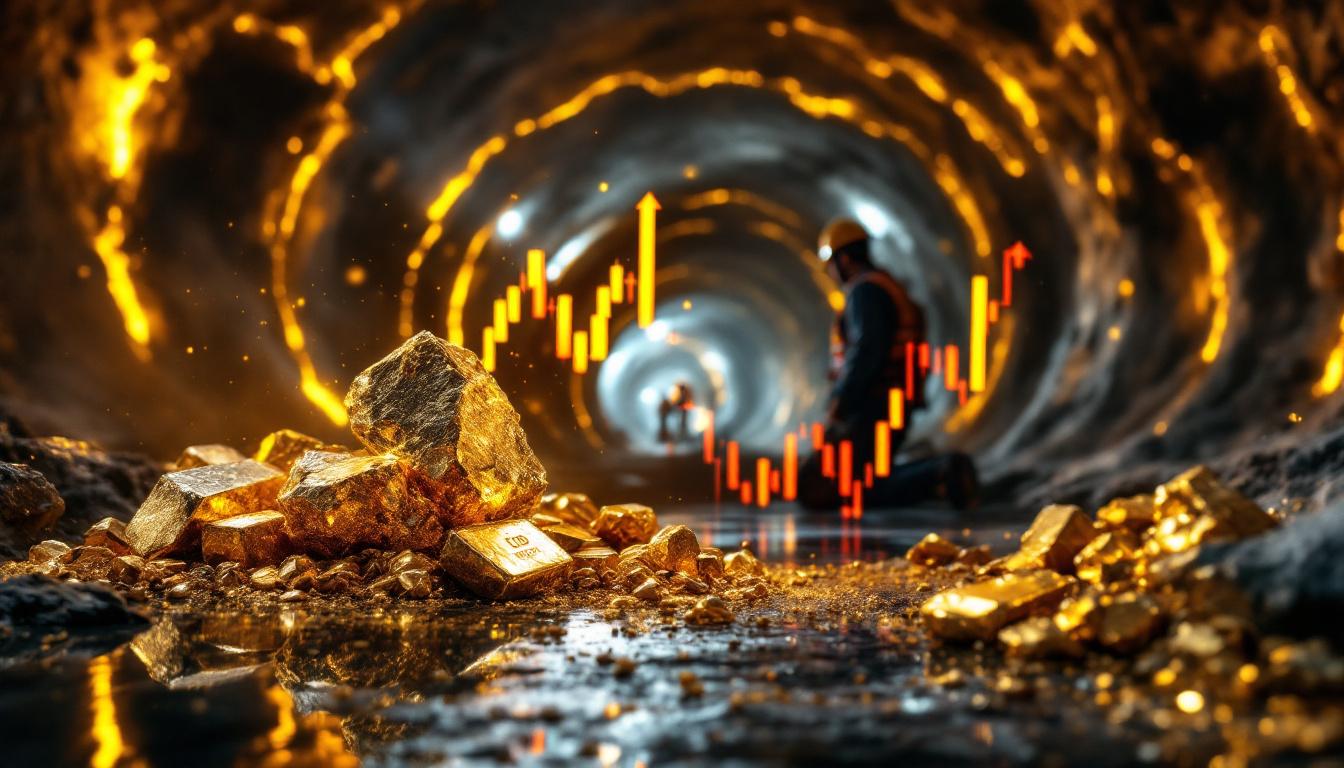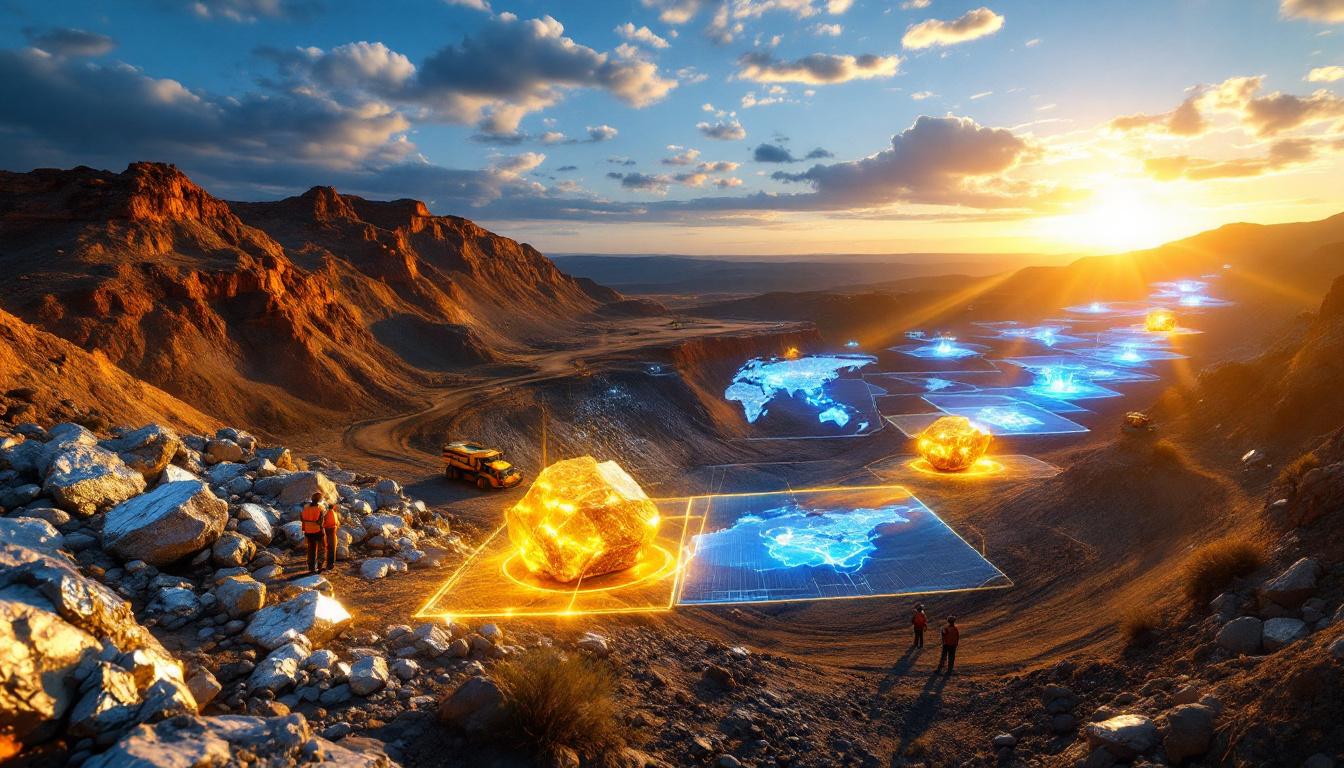China's Strategic Grip: Critical Mineral Export Controls and Global Implications
China's dominance in critical minerals represents one of the most significant yet underappreciated geopolitical leverage points in today's international relations. With control over processing facilities that handle 92% of the world's refined rare earth elements according to the U.S. Geological Survey's 2024 Mineral Commodity Summaries, Beijing has positioned itself at the center of supply chains crucial for everything from smartphones to fighter jets. This crackdown on illegal mines and China mineral controls is reshaping the global resource landscape.
Understanding China's Dominance in the Critical Minerals Market
China's commanding position in critical minerals stems not just from its natural geological endowment—which accounts for approximately 35% of global rare earth reserves—but from decades of strategic investment in processing capabilities that other nations have largely neglected.
"China's rare earth dominance is not just about mining but refining—a capability few nations have replicated," explains Jane Nakano, Senior Fellow at the CSIS Energy Security Program. This refinement expertise involves sophisticated solvent extraction and ion-exchange processes that Chinese companies have optimized over decades, creating barriers to entry that competitors struggle to overcome.
Beijing's export regulations have evolved into a comprehensive system requiring companies to obtain regulatory approvals before shipping minerals overseas. Under China's Export Control Law (enacted in 2020) and subsequent Customs Export Regulations, all 17 rare earth elements now require export licenses administered through the Ministry of Commerce (MOFCOM).
The practical implications are significant—these critical minerals serve as essential components in:
- High-performance electronics including smartphones, laptops, and medical equipment
- Clean energy technologies such as wind turbines and electric vehicle batteries
- Advanced defense systems including radar systems, guided missiles, and night vision devices
- Next-generation computing hardware necessary for AI and quantum computing
What's particularly noteworthy is that China consumes approximately 60% of its rare earth production domestically, according to CRU Group analysis from 2024, demonstrating the strategic importance these materials play in China's own industrial development.
The Strategic Importance of Critical Minerals
Critical minerals represent far more than just commodities—they're the foundation of technological sovereignty in the 21st century. Their applications span:
- Energy transition technologies: Permanent magnets containing neodymium and dysprosium enable efficient wind turbines and electric motors
- Digital infrastructure: Gallium and germanium are crucial for semiconductor manufacturing
- National security applications: Night vision devices require yttrium, while missile guidance systems depend on samarium-cobalt magnets
- Medical technologies: MRI machines utilize superconducting magnets containing rare earth elements
"Export controls are a strategic tool, not just trade policy," notes David Abraham, Energy Transition Strategist and author of "The Elements of Power." This perspective reveals why China has integrated mineral supply chains into its broader geopolitical strategy—they provide economic and diplomatic advantages that extend well beyond simple market dominance.
The strategic importance is magnified by the fact that many critical minerals have no effective substitutes without significant performance compromises. For example, replacing neodymium-iron-boron magnets in electric vehicles would result in dramatically reduced efficiency and range. Furthermore, these materials play a vital role in critical minerals energy security as nations transition toward greener technologies.
Why Is China Tightening Control Over Critical Minerals?
The intensification of China's crackdown on illegal mines and China mineral controls comes amid a complex geopolitical landscape dominated by escalating tensions with the United States and growing concerns about resource security.
Escalating US-China Trade Tensions
Recent U.S. export restrictions have reignited bilateral tensions to levels not seen since the height of the 2018-2020 trade war. In April 2025, the U.S. Department of Commerce added 37 Chinese entities to its Entity List for ties to semiconductor manufacturing, according to Federal Register documents. These restrictions limit Chinese access to jet engine technology and advanced chip design capabilities.
Washington has specifically accused Beijing of failing to honor commitments to lift restrictions on seven key minerals that were previously negotiated in bilateral talks. These minerals—gallium, germanium, graphite, cobalt, lithium, nickel, and manganese—form the backbone of next-generation technologies.
Trade representatives from both nations have engaged in increasingly tense discussions about mineral export policies. U.S. Trade Representative Jamieson Greer stated in May 2025: "China's continued restrictions on critical minerals represent a clear violation of previous agreements and threaten supply chains vital to American innovation."
In response, China's Commerce Ministry spokesperson characterized American demands as "unreasonable interference in normal trade regulation" and pointed to U.S. technology restrictions as justification for China's cautious approach to mineral exports, according to recent Chinese media reports.
Strategic Resource Protection Measures
Beyond immediate trade tensions, China's mineral strategy reflects a deeper "whole-chain" control directive emanating from Beijing's highest levels. State Council Document No. 2025-12 mandates comprehensive oversight of strategic minerals from extraction through processing and export.
The directives serve multiple strategic objectives:
- Supply chain dominance maintenance: By controlling processing bottlenecks, China retains leverage over global technology sectors
- Domestic industry protection: Ensuring Chinese manufacturers receive preferential access to critical inputs
- Technological development security: Supporting China's own advanced manufacturing ambitions
- Resource security enhancement: Managing extraction rates to extend resource lifespans while minimizing environmental damage
"China views minerals as leverage in tech wars—a response to U.S. chip sanctions," explains Kevin Book of ClearView Energy Partners. This perspective underscores how mineral controls have become integrated into broader technology competition.
The environmental justification for tighter controls shouldn't be overlooked. China's 2025 Ecological Protection Law Amendments tie mining permits directly to emissions standards and water protection requirements, addressing legitimate environmental concerns while simultaneously serving strategic objectives.
How Is China Enforcing Critical Mineral Controls?
China's enforcement of mineral controls operates through regional initiatives, technological monitoring systems, and crackdowns on illegal mining operations—creating a multi-layered approach to resource governance.
Regional Enforcement Initiatives
The Guangxi Zhuang autonomous region has emerged as a frontline in China's mineral control strategy, implementing enhanced export oversight that includes satellite monitoring and AI-powered detection of unauthorized mining operations. According to China Daily reporting from April 2025, these systems can identify mining activity through subtle land-use changes invisible to conventional monitoring.
Guizhou province has taken a compliance-focused approach, conducting operational inspections that revealed 45% of exporters failed to meet regulatory requirements in 2024, according to the Guizhou Commerce Bureau. These inspections focus on documentation verification, proper licensing, and adherence to quota limitations.
Hunan province has pioneered "smart mining" sensors to track extraction volumes in real-time, creating a comprehensive map of strategic mineral exporters while strengthening compliance systems. This digital infrastructure enables provincial authorities to monitor resource flows with unprecedented precision.
Perhaps most notable is the cross-regional coordination between cities like Wuzhou (Guangxi) and Yunfu (Guangdong), which operate a shared database to track mineral shipments. This coordination led to the seizure of 500 tons of illegally mined graphite in May 2025, according to Securities Times reporting from June 4, 2025.
Crackdown on Illegal Mining Operations
China's enforcement actions against illegal mining have intensified dramatically, with penalties increased to five times the revenue generated from illegal operations, according to 2024 guidelines from the Ministry of Natural Resources.
The crackdown has produced tangible results:
- Guangxi authorities shut down 23 illegal rare earth mining operations in Q1 2025 alone
- Inner Mongolia's Bayan Obo mine—historically one of China's largest rare earth producers—was temporarily closed in 2024 for environmental violations
- Joint task forces across provincial boundaries have dismantled organized smuggling networks
- Environmental remediation requirements have been imposed on sites of illegal extraction
These enforcement actions reflect both resource security concerns and legitimate environmental protection efforts. Illegal mining typically involves environmentally destructive practices including uncontrolled acid leaching, wastewater discharge, and radiation exposure risks.
A mining industry analyst with direct knowledge of Chinese operations noted: "The environmental damage from unregulated rare earth mining can persist for decades. The government crackdown serves both environmental and strategic objectives simultaneously." Moreover, these enforcement measures are increasingly shifting the global mining landscape as companies seek more reliable sources.
What Are the Components of China's "Whole-Chain" Control Strategy?
China's comprehensive approach to mineral resource governance encompasses sophisticated regulatory frameworks, technological monitoring, and strategic quota management.
Export Licensing and Approval Systems
At the core of China's control strategy is a comprehensive licensing framework that requires multiple approvals for mineral exports:
- Export licenses: MOFCOM issues these based on exporter credentials, compliance history, and alignment with national quotas
- End-use certificates: Importers must submit detailed documentation regarding intended applications
- Quality verification: Testing to ensure minerals meet claimed specifications and aren't misclassified
- Quota compliance: Verification that shipments adhere to national and regional export limitations
The 2025 quota for rare earth exports stands at 35,000 tons, according to MOFCOM's December 2024 announcement. This represents a 15% reduction from the previous year, reflecting growing concerns about resource depletion and strategic priorities.
"China's system is designed to prevent a repeat of the 2010 rare earth embargo backlash," explains Eugene Gholz, a former U.S. Defense Department adviser. "Today's controls are more sophisticated, less visible, and harder to challenge through WTO mechanisms."
The licensing system also incorporates risk assessment for sensitive technologies. Exports destined for military applications or competitive industries receive additional scrutiny, with some applications facing extended review periods or outright rejection.
Supply Chain Mapping and Monitoring
China's supply chain visibility has reached unprecedented levels, with over 1,200 companies now registered in a national mineral tracking database according to the Ministry of Industry and Information Technology. This system enables authorities to:
- Track material flows: Following minerals from extraction through processing and export
- Monitor production capacities: Identifying potential overcapacity or unauthorized expansion
- Verify compliance: Ensuring adherence to environmental, safety, and export regulations
- Detect anomalies: Identifying potential illegal operations or smuggling attempts
Particularly innovative is the pilot implementation of blockchain technology for cobalt exports through Ant Group's AntChain platform, as reported by Caixin in March 2025. This system creates an immutable record of mineral custody from mine to market, enhancing traceability while reducing documentation fraud.
Digital monitoring extends to transportation networks, with checkpoints on key routes equipped with specialized sensing equipment that can detect mineral shipments without physical inspection. This technology has proven particularly effective in identifying smuggling attempts through secondary ports and border crossings.
"The comprehensiveness of China's mineral monitoring system is unmatched globally," notes Ryan Castilloux of Adamas Intelligence. "It's not just about export control—it's about creating visibility throughout the entire value chain."
How Will China's Mineral Controls Impact Global Markets?
The strategic implications of China's tightened mineral controls are reverberating through global supply chains, creating both challenges and opportunities for different stakeholders.
Implications for International Supply Chains
The immediate impact has manifested in significant price volatility across critical mineral markets. Neodymium prices surged 30% in Q2 2025 according to Benchmark Mineral Intelligence, triggering concern among manufacturers of everything from electric vehicles to wind turbines.
Beyond price effects, manufacturers face broader supply chain challenges:
- Delivery uncertainties: Unpredictable approval timelines for export licenses
- Quality consistency issues: As alternative suppliers with less experience enter the market
- Specification limitations: Some specialized grades remain available only from Chinese producers
- Increased compliance burdens: More documentation and verification requirements
These disruptions are particularly acute for manufacturers with just-in-time production systems and limited inventory buffers. Several major EV manufacturers have reported production delays attributed directly to rare earth supply constraints.
The downstream effects extend to consumer electronics, where manufacturers are redesigning products to reduce dependence on volatile mineral supplies. Apple's 2025 Environmental Report notes the company recovered 2,600 tons of rare earths through its recycling initiatives, reflecting a growing emphasis on circular supply chains.
Strategic Responses from Other Nations
Nations and corporations are responding to China's mineral strategy with unprecedented investment in alternative supply chains:
- New mining projects: Australia's Lynas Corporation plans to double its rare earth processing capacity by 2026, according to Reuters reporting from May 2025
- Strategic investments: Tesla committed $1.5 billion to Quebec lithium projects in 2024, securing lithium supply for battery materials
- Government interventions: The U.S. invoked the Defense Production Act to fund expansion of MP Materials' California mine
- International partnerships: The Minerals Security Partnership launched by G7 nations coordinates investment in non-Chinese supply chains
"Every nation is scrambling for non-Chinese supplies, but progress is slow," cautions Ryan Castilloux of Adamas Intelligence. This reality reflects the significant lead time required to develop new mining operations and processing facilities—typically 7-10 years from discovery to production.
Research into substitute materials has accelerated, with Airbus's HADES project developing motors that reduce dysprosium requirements by 50%. Similarly, the U.S. Critical Materials Institute has pioneered cerium-based magnets that could replace certain neodymium applications.
Important note for investors: While alternative supply chains are developing, China will likely maintain processing dominance for at least the next 5-7 years. Companies highly dependent on rare earth inputs face significant medium-term supply risks.
FAQ: Critical Minerals and Export Controls
What are rare earth elements and why are they important?
Rare earth elements comprise 17 metallic elements in the periodic table (15 lanthanides plus scandium and yttrium) with unique magnetic, luminescent, and electrochemical properties. Despite their name, most are relatively abundant in Earth's crust but rarely concentrated in economically viable deposits.
Their importance stems from irreplaceable roles in:
- Permanent magnets: Neodymium, praseodymium, dysprosium and terbium enable small, powerful magnets crucial for electric motors and wind turbines
- Catalysts: Lanthanum and cerium serve as petroleum refining catalysts and in catalytic converters
- Phosphors: Europium, terbium, and yttrium create colors in displays and energy-efficient lighting
- Polishing compounds: Cerium oxide provides precision polishing for semiconductor manufacturing
- Defense applications: Various rare earths are essential in guidance systems, radar, and night vision equipment
The concentration of processing capacity in China creates strategic vulnerabilities, as these materials have few viable substitutes without significant performance compromises.
How do export controls affect international businesses?
Export controls create multifaceted challenges for international businesses that extend well beyond simple supply disruptions:
- Regulatory complexity: Companies must navigate approval processes that frequently change with limited transparency
- Documentation burden: Extensive end-use certifications and verification requirements increase administrative costs
- Supply uncertainty: Approval timelines can vary unpredictably, complicating production planning
- Price volatility: Limited spot markets and concentrated supply create conditions for rapid price fluctuations
- Strategic planning complications: Long-term investment decisions must account for geopolitical supply risks
Businesses most affected include electric vehicle manufacturers, wind turbine producers, electronics companies, and defense contractors. Many have responded by increasing inventory buffers, diversifying suppliers where possible, and redesigning products to reduce dependence on the most vulnerable materials.
What alternatives exist to Chinese critical mineral supplies?
Several promising alternatives to Chinese mineral supplies are emerging, though each faces significant challenges:
-
New mining projects:
- Australia's Mount Weld (Lynas Corporation) is expanding production of light rare earths
- Greenland's Kvanefjeld project contains one of the world's largest rare earth deposits outside China
- Canada's Strange Lake deposit represents a significant heavy rare earth resource
-
Recycling technologies:
- Urban Mining Company recovers neodymium from hard drive magnets
- Honda and Japan's JOGMEC have developed processes to recycle rare earths from nickel-metal hydride batteries
- The EU's REE4EU project demonstrates industrial-scale rare earth recovery from end-of-life products
-
Substitute materials:
- Ferrite magnets can replace some neodymium magnets in less demanding applications
- Induction motors avoid rare earth requirements in some electric vehicles
- Silicon carbide semiconductors can replace gallium nitride in certain applications
-
Supply chain restructuring:
- Vertical integration strategies secure priority access to limited supplies
- Joint ventures between manufacturers and mining companies align incentives
- Strategic stockpiling buffers short-term supply disruptions
Disclaimer: The development of alternative supply chains involves significant geological, technical, and financial uncertainties. Investors should carefully evaluate the specific challenges facing individual projects before making investment decisions.
What's driving China's intensified enforcement of mineral controls?
China's enforcement of mineral controls reflects a convergence of strategic, economic, and environmental factors:
- Technology competition: Critical minerals provide leverage in broader technology conflicts with the United States
- Resource conservation: Concerns about depleting strategic resources that support domestic manufacturing
- Environmental protection: Legitimate efforts to address the significant ecological damage
Ready to Stay Ahead of Major Mineral Discoveries?
Ensure you never miss the next major ASX mining discovery by subscribing to Discovery Alert's proprietary Discovery IQ model, which delivers real-time notifications on significant mineral discoveries before the broader market reacts. Explore how historic discoveries have generated substantial returns by visiting Discovery Alert's dedicated discoveries page and position yourself for your 30-day free trial today.




